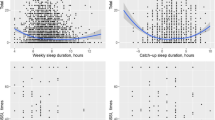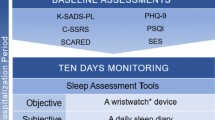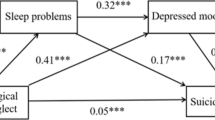Abstract
Non-suicidal self-injury (NSSI) is prevalent and is associated with increased risk of suicidal behavior in adolescents. This study examined which sleep variables are associated with NSSI, independently from demographics and mental health problems in Chinese adolescents. Participants consisted of 2090 students sampled from three high schools in Shandong, China and had a mean age of 15.49 years. Participants completed a sleep and health questionnaire to report their demographic and family information, sleep duration and sleep problems, impulsiveness, hopelessness, internalizing and externalizing problems, and NSSI. A series of regression analyses were conducted to examine the associations between sleep variables and NSSI. Of the sample, 12.6 % reported having ever engaged in NSSI and 8.8 % engaged during the last year. Univariate logistic analyses demonstrated that multiple sleep variables including short sleep duration, insomnia symptoms, poor sleep quality, sleep insufficiency, unrefreshed sleep, sleep dissatisfaction, daytime sleepiness, fatigue, snoring, and nightmares were associated with increased risk of NSSI. After adjusting for demographic and mental health variables, NSSI was significantly associated with sleeping <6 h per night, poor sleep quality, sleep dissatisfaction, daytime sleepiness, and frequent nightmares. Stepwise logistic regression model demonstrated that poor sleep quality (OR = 2.18, 95 % CI = 1.37–3.47) and frequent nightmares (OR = 2.88, 95 % CI = 1.45–5.70) were significantly independently associated with NSSI. In conclusion, while multiple sleep variables are associated with NSSI, poor sleep quality and frequent nightmares are independent risk factors of NSSI. These findings may have important implications for further research of sleep self-harm mechanisms and early detection and prevention of NSSI in adolescents.
Similar content being viewed by others
References
Zetterqvist M (2015) The DSM-5 diagnosis of nonsuicidal self-injury disorder: a review of the empirical literature. Child Adolesc Psychiatry Ment Health 9:31
Hawton K et al (2015) Interventions for self-harm in children and adolescents. Cochrane Database Syst Rev 12:CD012013
Hawton K et al (2012) Repetition of self-harm and suicide following self-harm in children and adolescents: findings from the multicentre study of self-harm in England. J Child Psychol Psychiatry 53(12):1212–1219
Swannell SV et al (2014) Prevalence of nonsuicidal self-injury in nonclinical samples: systematic review, meta-analysis and meta-regression. Suicide Life Threat Behav 44(3):273–303
Hawton K, James A (2005) Suicide and deliberate self harm in young people. BMJ 330(7496):891–894
Shek DT, Yu L (2012) Self-harm and suicidal behaviors in Hong Kong adolescents: prevalence and psychosocial correlates. Sci World J 2012:932540
Wan YH et al (2011) Deliberate self-harm behaviors in Chinese adolescents and young adults. Eur Child Adolesc Psychiatry 20(10):517–525
Wan Y et al (2015) Impact of childhood abuse on the risk of non-suicidal self-injury in mainland Chinese adolescents. PLoS One 10(6):e0131239
Giletta M et al (2012) Adolescent non-suicidal self-injury: a cross-national study of community samples from Italy, the Netherlands and the United States. Psychiatry Res 197(1–2):66–72
Brent DA et al (1999) Age- and sex-related risk factors for adolescent suicide. J Am Acad Child Adolesc Psychiatry 38(12):1497–1505
Carroll R et al (2015) Self-cutting and risk of subsequent suicide. J Affect Disord 192:8–10
Cooper J et al (2005) Suicide after deliberate self-harm: a 4-year cohort study. Am J Psychiatry 162(2):297–303
Hawton K, Saunders KE, O’Connor RC (2012) Self-harm and suicide in adolescents. Lancet 379(9834):2373–2382
McLoughlin AB, Gould MS, Malone KM (2015) Global trends in teenage suicide: 2003–2014. QJM 108(10):765–780
Guan K, Fox KR, Prinstein MJ (2012) Nonsuicidal self-injury as a time-invariant predictor of adolescent suicide ideation and attempts in a diverse community sample. J Consult Clin Psychol 80(5):842–849
Wilkinson P et al (2011) Clinical and psychosocial predictors of suicide attempts and nonsuicidal self-injury in the adolescent depression antidepressants and psychotherapy trial (ADAPT). Am J Psychiatry 168(5):495–501
Maciejewski DF et al (2014) Overlapping genetic and environmental influences on nonsuicidal self-injury and suicidal ideation: different outcomes, same etiology? JAMA Psychiatry 71(6):699–705
Brent DA et al (2013) Protecting adolescents from self-harm: a critical review of intervention studies. J Am Acad Child Adolesc Psychiatry 52(12):1260–1271
Liu X et al (2008) Sleep patterns and problems among chinese adolescents. Pediatrics 121(6):1165–1173
Owens J (2014) Insufficient sleep in adolescents and young adults: an update on causes and consequences. Pediatrics 134(3):e921–e932
Roberts RE, Roberts CR, Chen IG (2001) Functioning of adolescents with symptoms of disturbed sleep. J Youth Adolesc 30:1–18
Roberts RE, Roberts CR, Duong HT (2008) Chronic insomnia and its negative consequences for health and functioning of adolescents: a 12-month prospective study. J Adolesc Health 42(3):294–302
Liu X (2004) Sleep and adolescent suicidal behavior. Sleep 27(7):1351–1358
Liu X, Buysse DJ (2006) Sleep and youth suicidal behavior: a neglected field. Curr Opin Psychiatry 19(3):288–293
Perlis ML et al (2015) Suicide and sleep: is it a bad thing to be awake when reason sleeps? Sleep Med Rev 29:101–107
Hysing M et al (2015) Sleep problems and self-harm in adolescence. Br J Psychiatry 207(4):306–312
Liu X, Zhao Z, Jia C (2015) Insomnia symptoms, behavioral/emotional problems, and suicidality among adolescents of insomniac and non-insomniac parents. Psychiatry Res 228(3):797–802
Liu X, Tein JY (2005) Life events, psychopathology, and suicidal behavior in Chinese adolescents. J Affect Disord 86(2–3):195–203
Levin R, Fireman G (2002) Nightmare prevalence, nightmare distress, and self-reported psychological disturbance. Sleep 25(2):205–212
Duval M, McDuff P, Zadra A (2013) Nightmare frequency, nightmare distress, and psychopathology in female victims of childhood maltreatment. J Nerv Ment Dis 201(9):767–772
Achenbach TM (1991) Manual for the youth self-report and 1991 profile. Department of Psychiatry. University of Vermont, Burlington
Liu X (1997) Reliability and validity of the youth self-report (YSR) of achenbach’s child behavior checklist (CBCL) (in Chinese). Chin Ment Health J 11(4):200–203
Beck AT et al (1974) The measurement of pessimism: the hopelessness scale. J Consult Clin Psychol 42(6):861–865
Martin G et al (2004) Sexual abuse and suicidality: gender differences in a large community sample of adolescents. Child Abus Negl 28(5):491–503
Zhang J, Lamis DA, Yuanyuan K (2012) Measuring Chinese psychological traits and social support with western developed instruments in psychological autopsy studies. J Clin Psychol 68(12):1313–1321
Eysenck SBG et al (1985) Age norms for impulsiveness, venturesomeness and empathy in adults. Pers Individ Differ 6(5):613–619
Agargun MY et al (1998) Repetitive and frightening dreams and suicidal behavior in patients with major depression. Compr Psychiatry 39(4):198–202
Tanskanen A et al (2001) Nightmares as predictors of suicide. Sleep 24(7):844–847
Matamura M et al (2014) Associations between sleep habits and mental health status and suicidality in a longitudinal survey of monozygotic twin adolescents. J Sleep Res 23(3):290–294
Pigeon WR, Pinquart M, Conner K (2012) Meta-analysis of sleep disturbance and suicidal thoughts and behaviors. J Clin Psychiatry 73(9):e1160–e1167
Wong MM, Brower KJ (2012) The prospective relationship between sleep problems and suicidal behavior in the national longitudinal study of adolescent health. J Psychiatr Res 46(7):953–959
Lundh L-G, Bjärehed J, Wångby-Lundh M (2012) Poor sleep as a risk factor for nonsuicidal self-injury in adolescent girls. J Psychopathol Behav Assess 35(1):85–92
Buysse DJ et al (1989) The Pittsburgh sleep quality index: a new instrument for psychiatric practice and research. Psychiatry Res 28(2):193–213
Harvey AG et al (2008) The subjective meaning of sleep quality: a comparison of individuals with and without insomnia. Sleep 31(3):383–393
Sullivan KA et al (2015) Characterizing self-reported sleep disturbance after mild traumatic brain injury. J Neurotrauma 32(7):474–486
Tham SW, Fales J, Palermo TM (2015) Subjective and objective assessment of sleep in adolescents with mild traumatic brain injury. J Neurotrauma 32(11):847–852
Choquet M, Menke H (1990) Suicidal thoughts during early adolescence: prevalence, associated troubles and help-seeking behavior. Acta Psychiatr Scand 81(2):170–177
Owens C et al (2016) Needs and fears of young people presenting at accident and emergency department following an act of self-harm: secondary analysis of qualitative data. Br J Psychiatr 208(3):286–291
Hawton K et al (2002) Deliberate self harm in adolescents: self report survey in schools in England. BMJ 325(7374):1207–1211
Roberts RE, Duong HT (2014) The prospective association between sleep deprivation and depression among adolescents. Sleep 37(2):239–244
Argyropoulos SV et al (2003) Correlation of subjective and objective sleep measurements at different stages of the treatment of depression. Psychiatry Res 120(2):179–190
Acknowledgments
This work was funded by Shandong Scientific Technique Development Plan (Grant No. 2014GSF118163) and National Natural Science Foundation of China (Grant No. 81573233).
Author information
Authors and Affiliations
Corresponding authors
Ethics declarations
This study has been approved by the research ethics committee of Shandong University, and has therefore been performed in accordance with the ethical standards laid down in the 1964 Declaration of Helsinki and its later amendments.
Conflict of interest
All authors have no conflict of interest to disclose.
Rights and permissions
About this article
Cite this article
Liu, X., Chen, H., Bo, QG. et al. Poor sleep quality and nightmares are associated with non-suicidal self-injury in adolescents. Eur Child Adolesc Psychiatry 26, 271–279 (2017). https://doi.org/10.1007/s00787-016-0885-7
Received:
Accepted:
Published:
Issue Date:
DOI: https://doi.org/10.1007/s00787-016-0885-7




